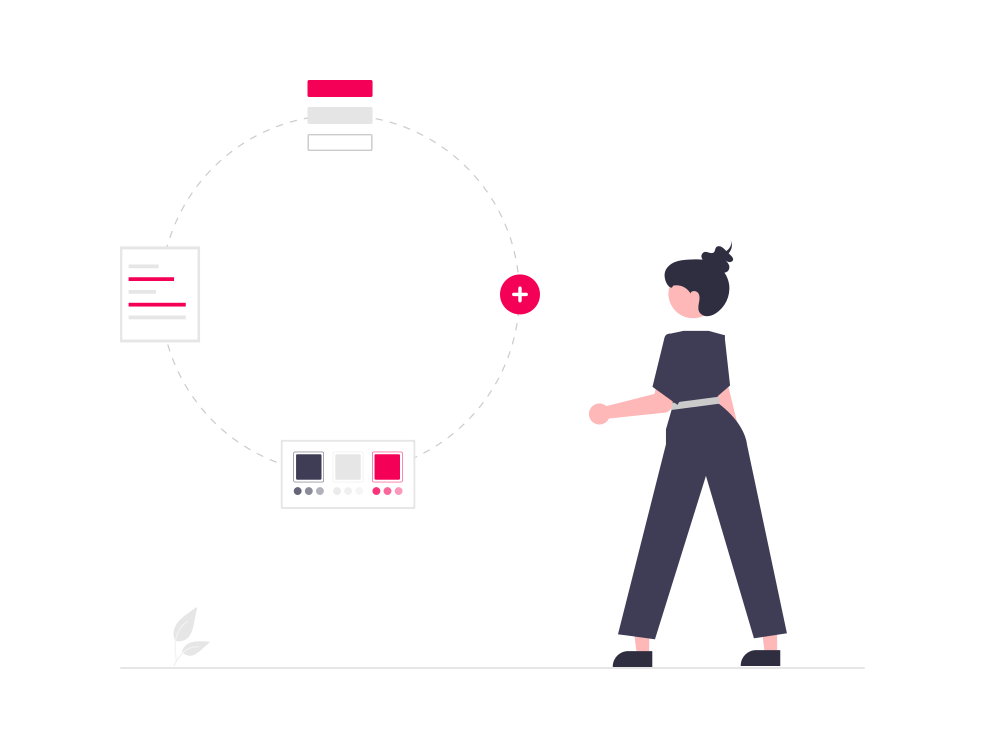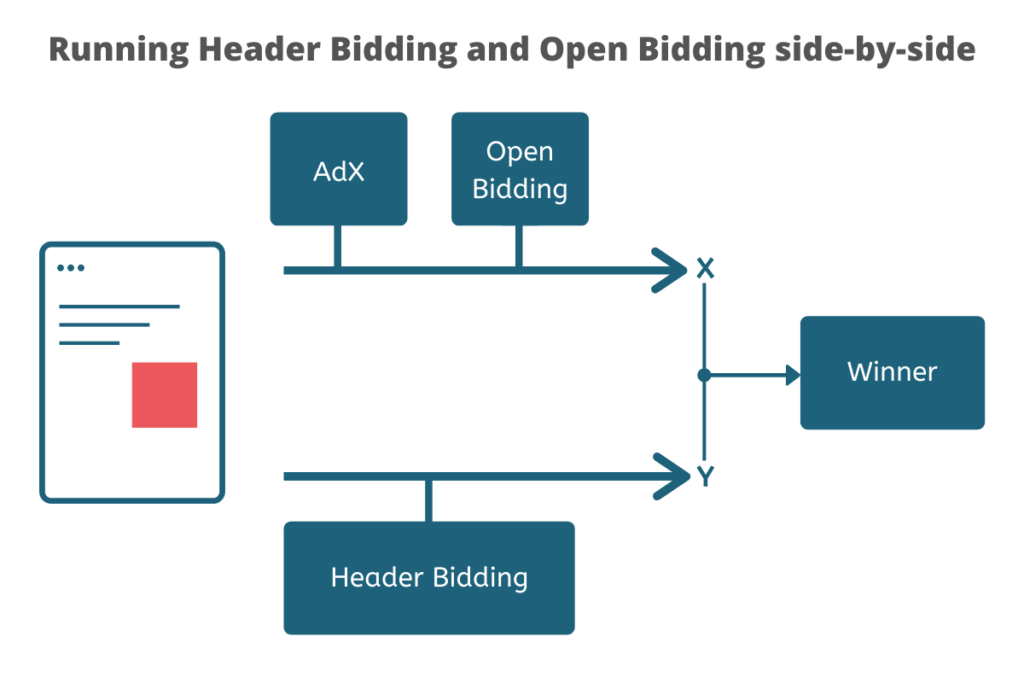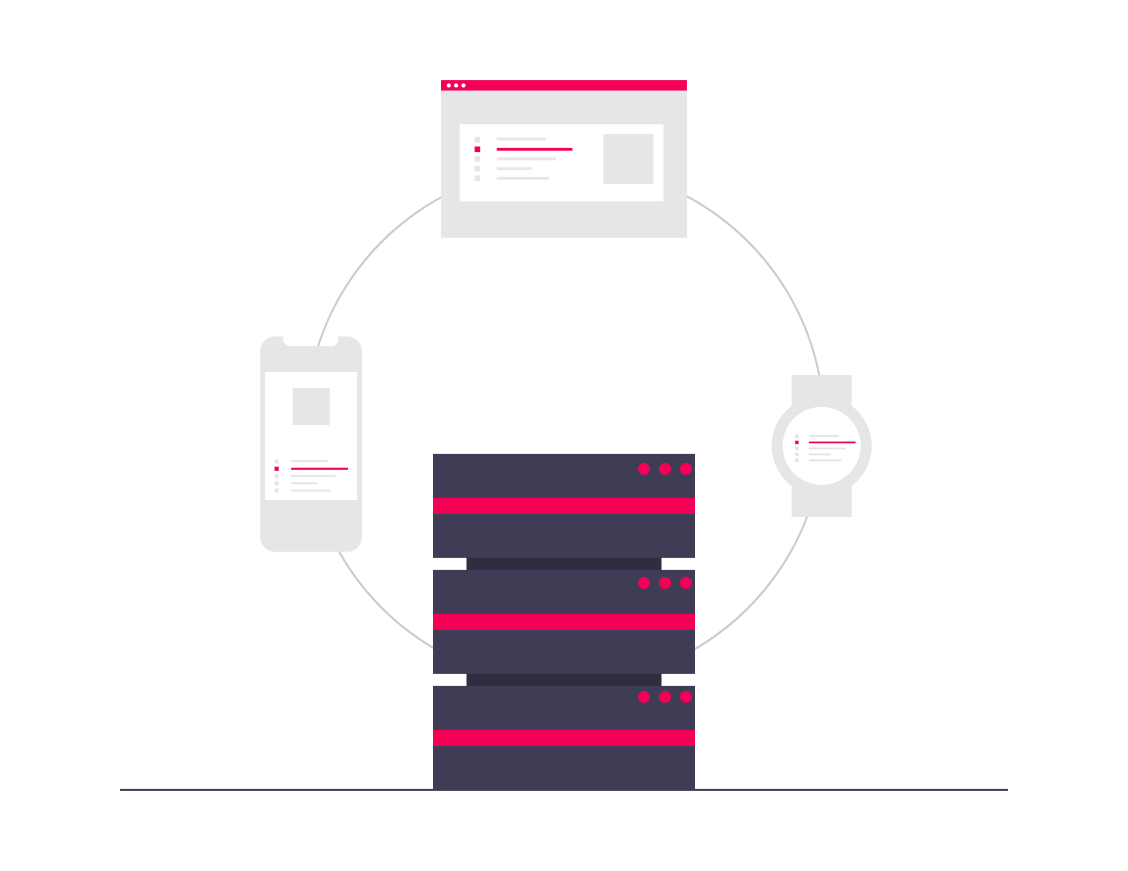Client-side header bidding vs server-side header bidding: Both techniques serve the same purpose – increasing bid competition and maximizing publishers’ ad revenue. But what really sets them apart, and how does it affect the auctions? Let’s find out.
Header bidding was introduced for publishers to reach out to more buyers and maximize yield. It served well for that matter. However, it came with its own challenges (page latency and browser limitations).
Due to these challenges, it became imperative to deal with its drawbacks. Hence, server-side header bidding and client-side header bidding were introduced.
Server-side header bidding, ad auctions take place on a centralised server instead of the user’s browser.
On the other hand, client-side header bidding operates through JavaScript running in the users’ browsers. This script sends ad requests dynamically, typically when the page loads and as the user interacts with the content
What is Client-side Header Bidding?
Client-side header bidding (A.K.A. browser-side header bidding or header bidding) is a process where publishers take the inventory to multiple demand partners as soon as an impression becomes available.
Every time an impression is available, ad requests are sent to demand partners to place their bids.
Then, the bids are compared with the floor price (set by the publisher). The highest bid is selected, and the winning bidder gets to display the ad.
This entire auction is conducted using an auction tag (Prebid.js) on the publisher’s website.
In simple words, this process requires a header bidding wrapper that goes into a web page’s head code, and the publisher gets to select the number of demand sources to plug into the wrapper.
How does Client-Side header Bidding Work?
Let’s check out what happens behind the scenes from the moment a user loads the page on the publisher’s website:
- As soon as the user opens the publisher’s website, the browser starts loading the webpage
- The header bidding JavaScript code or an auction tag (Prebid.js) located on the publisher’s webpage sends a request to third-party platforms or demand partners to participate in the auction.
- As soon as the bids start coming in, using real-time bidding, the highest bidder wins the auction and moves to the publisher’s ad server.
- Then, the winner competes with the publisher’s direct deals.
- At last, the ad server picks the highest bidders and serves their ad.
Even though the highest bidder wins the auction, the speed at which these bids are placed varies. It is because of this arrangement, many demand partners are left under potential timeouts to prevent slower page load times. On average, timeout ranges for browsers are between 400-800 milliseconds and for mobile browsers, it is between 800-1200 milliseconds.
As convenient as this process looks, client-side header bidding offers amazing benefits to the publishers. Let’s have a look.
Pros of Client-Side Header Bidding
Cookie Matching: Advertisers benefit from client-side header bidding because ad tech vendors that represent publishers and advertisers can sync their cookies to understand the user pattern and identify the user or publisher’s website.
Simple Implementation: With minimal technical infrastructure requirements, client-side header bidding is perfect for publishers looking for a straightforward approach to maximize their revenue.
Better Control: Publishers control timeout settings, adjust configuration, and oversee how the bidding is managed.
More Data: Client-side header bidding gives publishers deeper insights regarding granular bidding data, for example, which advertiser placed a bid and at what price.
Cons of Client Side Header Bidding
Page Latency: Publishers and users might face slower load times on older devices or due to internet connectivity, or the condition of the device.
Less Compatible: Ad blockers and browser compatibility are two main problems when working with client-side header bidding.
Dependency on Bidder: If the bidder becomes unresponsive, the whole auction process is impacted, it also impact ad delivery and revenue at the same time.
Before you go further:
Read how AdPushup’s Header Bidding solution helped All Garage Floors achieve a 1.8X revenue uplift.
What is Server-side Header Bidding?
Server-side header bidding, also known as server-to-server header bidding, is a technique in which the auction takes place on a server instead of the user’s browser.
This was introduced to counter the page latency problem that prevails in client-side header bidding. Once an impression is available, a single ad request is sent to the server from the browser.
The server picks the request and calls the demand partners to execute the auction. Once the bid is sold, the ad is displayed without affecting the page load time.
Now that you have a clear understanding of client-side vs server-side header bidding, let’s talk about why you should rely on client-side header bidding

How does Server-side Header Bidding Work?
As the name suggests, in server-side header bidding, the ad server sends bid requests to multiple demand partners through a common server. Concurrently, the bid response is measured by the same server to select the highest bidder and display their ads. Let’s understand the whole process behind server-side header bidding.
- Once the user enters the publisher’s website, the auction tag or the JavaScript tag installed between the webpage triggers the request to the ad server.
- In the case of server-side header bidding, the ad server is usually hosted by an S2S header bidding company.
- Then the ad server sends a bid request to ad exchanges as well.
- The highest bidder gets selected, and the corresponding ad gets displayed.
Pros of Server-Side Header Bidding
Reduced Page Latency: Server-side header bidding ad auctions take place on an external server instead of a browser, which reduces the page load time.
Increased Competition: With multiple demand partners bidding simultaneously, it often results in higher CPMs(cost per thousand impressions) and better fill rates.
Better Privacy: The dependence on third-party cookies is negligible, leading to better privacy for the users.
Cons of Server-Side Header Bidding
Complex Process: Implementing server-side header bidding requires technical expertise that can act as a barrier for publishers with limited resources.
Dependency on Server: The Central server is the backbone of the entire auction process. If the server faces any issue, it can lead to the failure of the whole auction process.
Which one to Choose: Client-Side vs Server-Side Header Bidding
Publisher’s Control
Client Side Header Bidding: With header bidding, publishers get to choose the buyers using the header bidding wrappers. Furthermore, floor price of each ad unit is decided by publishers. Consequently, the entire auction process becomes transparent for publishers and advertisers.
Server Side Header Bidding: However, server-side doesn’t offer such transparency for publishers. Surely, floor price is decided by publishers, but they don’t see buyers participating in the auction and the auction process remains hidden.
Auction management
Client Side Header Bidding: Header bidding wrappers allow publishers to control and manage the auction. Using the wrappers, publishers add buyers, set up time-out settings, and make sure all buyers get the bid requests simultaneously.
Server-side header bidding: The Server reaches out to buyers and sends them bid requests; hence, it is managed by the server.
In short, with server-side, most management tasks remain in the hands of the server rather than the publishers.
Cookie Matching
Client-side header bidding: Advertisers access the ad units directly from publishers’ web pages using the wrapper, which gives access to the user’s cookie data.
Server-side header bidding lacks cookies matching. This is because most user data is filtered while syncing the publisher’s and server’s DMP.
Interested buyers:
Client-side header bidding is still preferred by most publishers and advertisers. This might be because of the transparency factor.
Server-side header bidding is still too young to be accepted by the ad industry.
Reduced Latency
Client-side header bidding: Auction takes place on the user’s browser Client-side header bidding leads to an increase in the page latency, affecting the overall user experience.
Server-side header bidding: Although latency time varies by milliseconds, since auction takes place on an external server page latency is lower than the client-side header bidding.
Demand partners
Client-side header bidding: It is not as flexible as publishers choose just the required number of buyers to make sure the impression is sold before the auction timeout.
Server-side header bidding: The Server sends a bid request to as many buyers as the publishers want. This increases competition and offers a better ad fill rate.
Video Header Bidding
Client-side header bidding: Videos are rich media files and hence take more time to load on web pages and client-side header bidding increases page latency. Therefore, can cause serious damage to user experience when used with client-side.
Server side header bidding: It doesn’t pose such complications and works perfectly for video header bidding.
Browser Request Limitation
Client-side header bidding: Web browsers have a limit to number of requests they can generate. As client-side header bidding takes place on the browser, publishers have a limited number of ad requests they can send via a browser during a session.
Server side header bidding: It doesn’t depend on browser to generate and send ad requests, rather ad server takes care of this.
What About Google Open Bidding (EBDA)?
Now that we have discussed client-side vs server-side programming and what factors you should consider when making your decision, let’s shift our focus to Google Open Bidding.
Looking at the tug-of-war between the client-side header bidding and server-side header bidding, Google launched EBDA (Exchange Bidding Dynamic Allocation, now Open Bidding) and called it Google’s header bidding. It can solve page latency problems and offers Google support.
Open Bidding is as good as server-side header bidding. But it’s not available to every publisher. To get access, you need to be partner with Google Certified Publishing Partners.
Google deals in Net-30 whereas most demand partners go for Net-45, -60, and -90 cycles. As the revenue cycle doesn’t line up, this discourages demand partners to choose Open Bidding. Hence, Open Bidding leads to comparatively low demand and reduced competition on inventory.
So, What Should You Choose?
It depends on you (publishers); also, your inventory type, demand, and market trends. As you can see, each of these header bidding processes has its own pros and cons. Hence, choosing a header bidding technology blindly is never recommended.
Ideally, a publisher should test them first and compare the results. The data generated by the results will give you the answer to your question‒which is better, client-side header bidding or server-side header bidding?
Alternatively, try Hybrid Header Bidding. The hybrid method allows publishers to run client-side and server-side auctions, together. Using Google Ad Exchange, publishers can make Google’s demand and header bidding compete for an impression.
Here’s how it works:

- Once an impression is available, ad requests are sent to Google AdX and header bidding.
- Within the AdX system, both AdX and Open Bidding buyers place their bids to win the impression.
- Meanwhile, header bidding starts collecting bid responses from its demand partners.
- Upon completion, AdX and Open Bidding pass on a buyer(X). Similarly, header bidding passes on another (Y).
- Finally, AdX compares these bids and chooses the winner (the highest bid).
This solves the issue of a lack of demand as AdX and header bidding are now involved, along with their buyers. To sum up, Hybrid Header Bidding means more demand, improved bids, and more revenue for publishers.
AdPushup Header Bidding Solution
Merely deploying header bidding in your ad stack isn’t enough. Consistently optimizing it with technical improvements is the need of the hour. This is what AdPushup’s header bidding solution does. Through our multiple optimization features using data science and machine learning, we help publishers maximize their yield.
With our header bidding solution, you get:
- Automatic demand partner selection according to optimum requirements
- Smart timeout management
- Freedom to bring your own demand
- Bid monitoring and discrepancy resolution
Read more about our product capability: Header Bidding
Key Takeaways:
- Client-side header bidding and server-side header bidding are two approaches for ad inventory management. The main key difference between them is the location at which the auction process takes place.
- For client-side header bidding, it’s the user’s browser using an auction tag, and for server-side header bidding central server controls the auction process.
- Server-side header bidding offers reduced latency, better fill rates, and increased competition from demand partners, leading to more ad revenue.
- On the other hand, client-side header bidding comes with the ability to manage auctions using HB wrappers, more transparency, and access to user cookies for better targeting.
- Hybrid header bidding is the perfect blend of both client-side and server-side header bidding.
- Adpushup offers multiple optimization features with comprehensive Header Bidding Solutions. Through their automatic demand partner selection, smart integration, and effective bid monitoring technology, publishers like you can get the most out of the revenue.
FAQs
Client-side header bidding uses a limited number of browser ports to send and receive information. Publishers could be denied access to the best bids if they request more partners than the available ports can accommodate.
S2S header bidding (also called server-side header bidding) is a programmatic technique in which the auction takes place on the ad server instead of the user’s browser. Your website can simultaneously work with multiple demand partners without compromising page speed.
With Open Bidding, you can invite third-party demand partners to bid on your inventory in a real-time, server-to-server auction. Trafficking, reporting, and billing are also simplified with Open Bidding in Ad Manager.
Client-side and server-side refers to whether the processing of a program is performed by the user’s computer or by the web server.
Client-side processing of a web page heavily relies on JavaScript and other browser-based technologies. This can be contrasted with server-side processing, which relies on the webserver to execute a program stored on the web server.
For example, in an online auction website that uses Javascript, the user’s web browser will send information about an auction to the web server. The web server will then run the client-side auction program, and return a web page to the user’s web browser with the results of the auction.
Client-side programming is especially useful in situations where the same program would need to be run many times on many different items (such as bids in an auction).
Server-side processing, on the other hand, is much more useful in situations where only one program (or a small set of related programs) would need to be run.
In the basic sense, server-side refers to the server computing code and delivering it, while client-side refers to the client computing code and delivering it.
If a website is delivered in its entirety from the server, then the server side is faster. If it’s delivered in part from the server and part from the client, then the client side is faster.
It also depends on the application, but client-side processing is generally faster. However, it has limitations: if the processor has a limited amount of memory or processing power, or if you are processing a large amount of data, server-side processing can be a better choice.
With client-side header bidding auction process takes place on the user’s device in the browser. With server-side header bidding, the auction process takes place on a centralized server.
Header Bidding is a technique through which publishers offer ad space to various demand partners using server-side platforms (SSPs). Server side platforms help publishers to manage, sell and optimize their ad inventory






